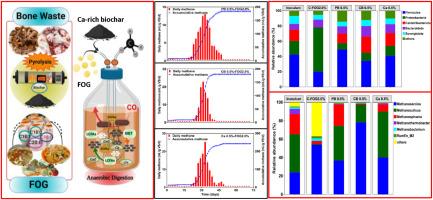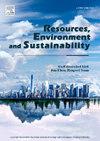富钙骨生物炭提高脂肪、油和油脂(FOG)的可生物降解性:甲烷最大化和微生物群落模式
IF 7.8
Q1 ENVIRONMENTAL SCIENCES
引用次数: 0
摘要
本研究评估了从猪和鸡骨头中提取的富钙骨生物炭,以增强对FOG(脂肪、油、油脂)的厌氧消化。该研究旨在通过减少长链脂肪酸(LCFAs)的负面影响来最大化能量回收,并评估其对微生物群落结构的后续影响。制备了一系列2.0% FOG批量试验,根据猪骨生物炭(PB)和鸡骨生物炭(CB)的钙含量分别添加,以维持(0.1、0.5和1.0%的钙浓度)。同时,在不使用生物炭的情况下,在相同浓度下使用Ca。添加0.5%的PB、CB和Ca分别提高了LCFAs的降解率,分别达到81.6%、81.0%和84.8%。因此,累积甲烷产量比对照FOG2.0 %分别提高了4倍、3.9倍和5.2倍。1.0%的PB、CB和Ca与0.5%相比,甲烷产量减少,但有趣的是,1.0%的PB和CB的累积甲烷产量分别为135.6 mL g−1 VS和125.3 mL g−1 VS,高于Ca (60.7 mL g−1 VS)。厚壁菌门(Firmicutes)和弯曲菌门(campylobacteria)的数量增加,同时在0.5% PB条件下Methanosarcina(从23.7%增加到78.1%)和0.5% Ca条件下Methanoculleus(从41.3%增加到50.0%)的数量也增加。富钙PB和CB生物炭通过减少抑制、刺激微生物、促进电子转移和改善养分供应等协同机制显著促进FOG厌氧消化。使用动物骨骼残留物进行FOG厌氧消化既提供了可持续的废物管理途径,又提供了有效的富钙材料,以促进能量回收。本文章由计算机程序翻译,如有差异,请以英文原文为准。

Calcium-rich bone biochar boosts fat, oil, and grease (FOG) biodegradability: Methane maximization and microbial community pattern
The present study evaluated calcium-rich bone biochar, derived from pig and chicken bones, for enhanced anaerobic digestion of FOG (fat, oil, grease). The study aimed to maximise energy recovery by reducing the negative impact of long-chain fatty acids (LCFAs) and to evaluate the subsequent effect on the microbial community structure. A series of 2.0 % FOG batch trials was prepared, adding pig bone biochar (PB) and chicken bone biochar (CB) based on their calcium (Ca) content to maintain (0.1, 0.5, and 1.0 % Ca concentrations). Parallelly, Ca was used at the same concentrations without biochar. Supplementation of 0.5 % PB, CB, and Ca individually enhanced LCFAs degradation up to 81.6 %, 81.0 %, and 84.8 %, respectively. Therefore, the accumulative methane yield increased by 4-, 3.9-, and 5.2-fold over the control FOG2.0 %. Reduction in methane production was observed at 1.0 % PB, CB, and Ca compared with 0.5 % but, interestingly, 1.0 % PB and CB showed higher accumulative methane yield of 135.6 mL g−1 VS and 125.3 mL g−1 VS, respectively, in comparison to Ca (60.7 mL g−1 VS). There was enhancement in Firmicutes and Campylobacteriotes, accompanied by a simultaneous rise in Methanosarcina at 0.5 % PB (from 23.7 % to 78.1 %) and Methanoculleus at 0.5 % Ca (from 41.3 % to 50.0 %). Ca-rich PB and CB biochar significantly enhanced FOG anaerobic digestion through synergistic mechanisms, including reducing inhibition, stimulating microbes, facilitating electron transfer, and improving nutrient supply. Using animal bone residues for FOG anaerobic digestion provides both a sustainable waste management route and an efficient calcium-rich material to boost energy recovery.
求助全文
通过发布文献求助,成功后即可免费获取论文全文。
去求助
来源期刊

Resources Environment and Sustainability
Environmental Science-Environmental Science (miscellaneous)
CiteScore
15.10
自引率
0.00%
发文量
41
审稿时长
33 days
 求助内容:
求助内容: 应助结果提醒方式:
应助结果提醒方式:


